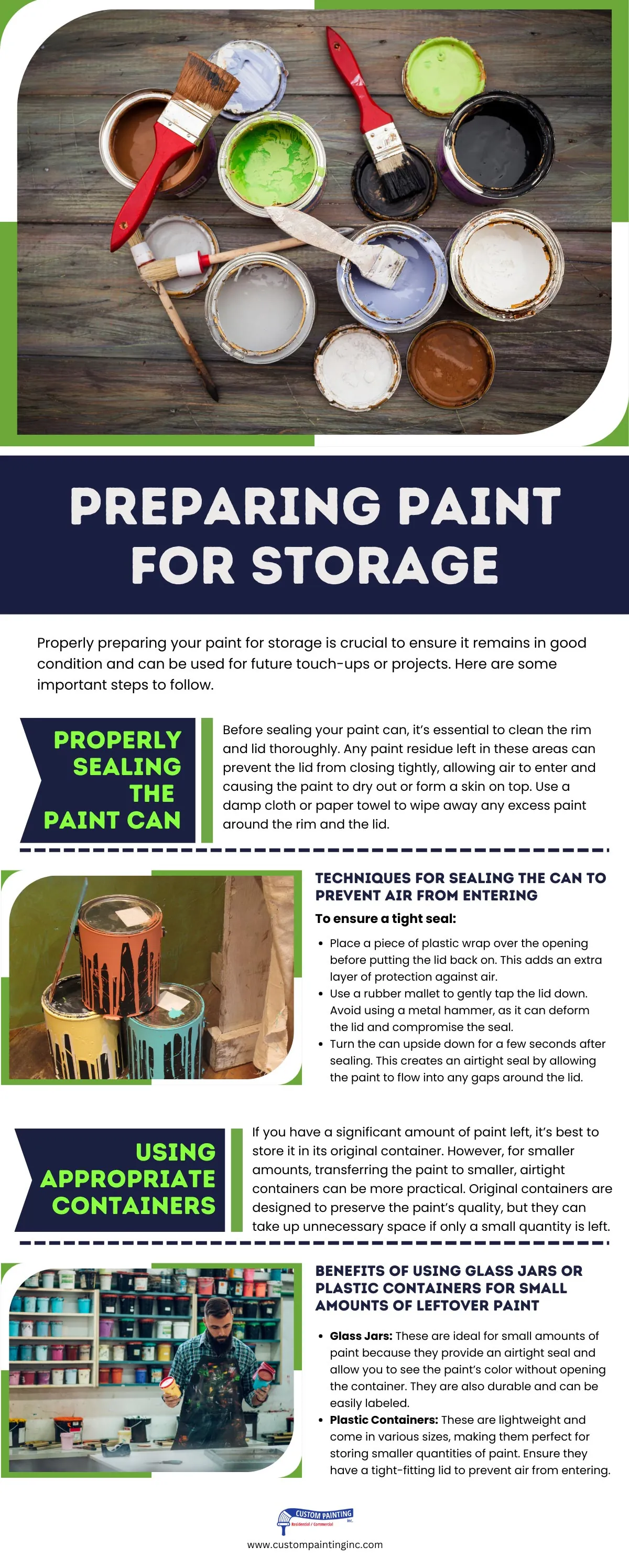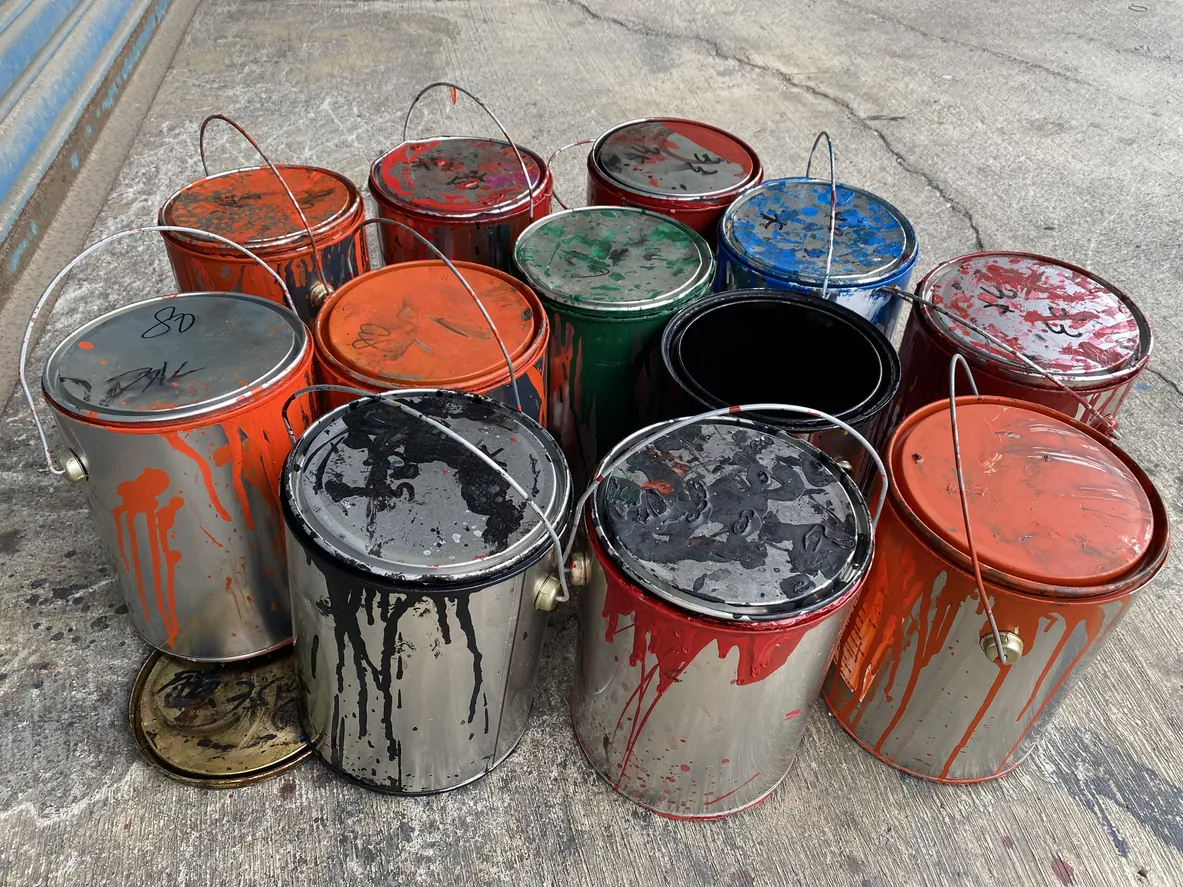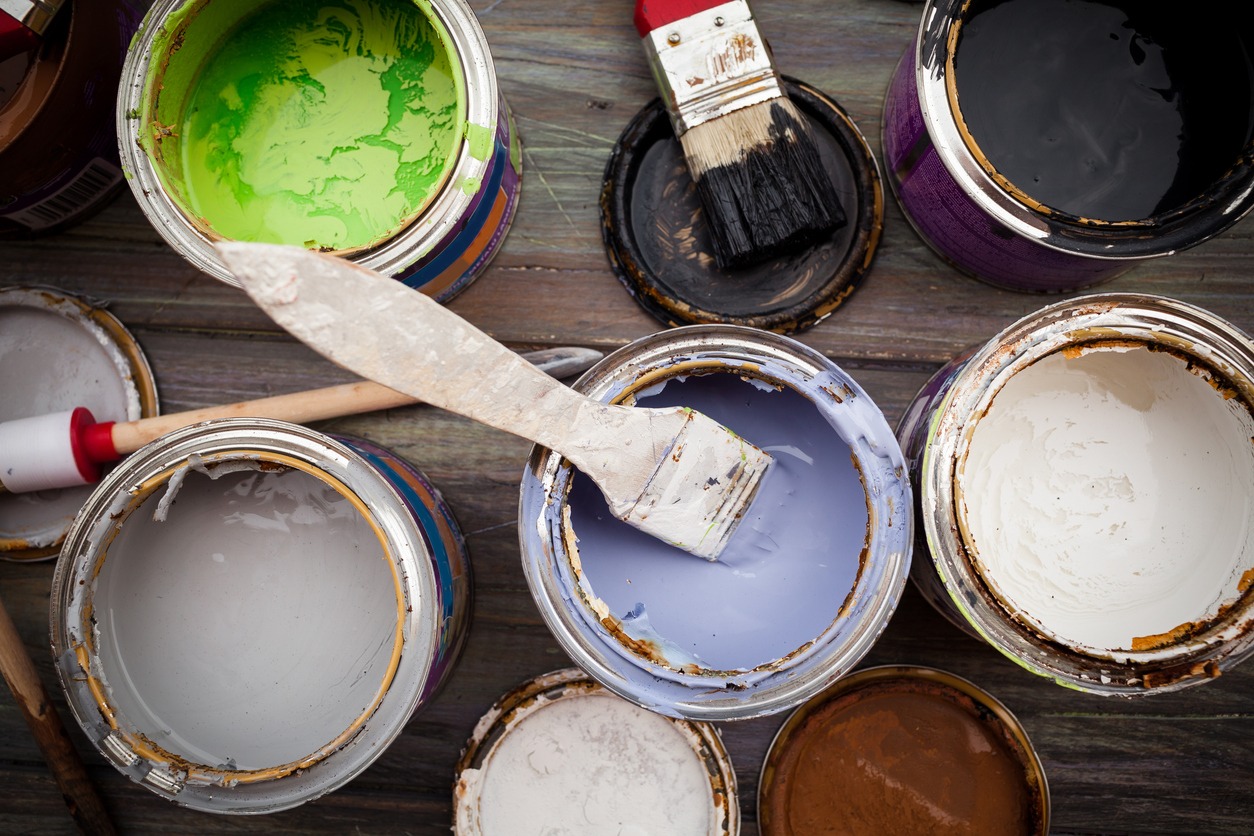Properly storing leftover paint can save money, help with future touch-ups, and reduce waste. Here are essential tips for storing any leftover paint effectively after house painting. Whether you’re a DIY enthusiast or a homeowner looking to keep your space fresh, knowing how to store paint correctly will ensure it remains usable for future projects. Follow these guidelines to keep your leftover paint in prime condition and ready for use whenever you need it.
Preparing Paint for Storage
Properly preparing your paint for storage is crucial to ensure it remains in good condition and can be used for future touch-ups or projects. Here are some important steps to follow.
Properly Sealing the Paint Can
Before sealing your paint can, it’s essential to clean the rim and lid thoroughly. Any paint residue left in these areas can prevent the lid from closing tightly, allowing air to enter and causing the paint to dry out or form a skin on top. Use a damp cloth or paper towel to wipe away any excess paint around the rim and the lid.
Techniques for Sealing the Can to Prevent Air from Entering
To ensure a tight seal:
- Place a piece of plastic wrap over the opening before putting the lid back on. This adds an extra layer of protection against air.
- Use a rubber mallet to gently tap the lid down. Avoid using a metal hammer, as it can deform the lid and compromise the seal.
- Turn the can upside down for a few seconds after sealing. This creates an airtight seal by allowing the paint to flow into any gaps around the lid.
Using Appropriate Containers
If you have a significant amount of paint left, it’s best to store it in its original container. However, for smaller amounts, transferring the paint to smaller, airtight containers can be more practical. Original containers are designed to preserve the paint’s quality, but they can take up unnecessary space if only a small quantity is left.
Benefits of Using Glass Jars or Plastic Containers for Small Amounts of Leftover Paint
- Glass Jars: These are ideal for small amounts of paint because they provide an airtight seal and allow you to see the paint’s color without opening the container. They are also durable and can be easily labeled.
- Plastic Containers: These are lightweight and come in various sizes, making them perfect for storing smaller quantities of paint. Ensure they have a tight-fitting lid to prevent air from entering.
By following these tips, you can keep your leftover paint in good condition and ready for use whenever needed.
Labeling the Paint
Properly labeling your leftover paint is essential for easy identification and future use. It ensures that you have all the necessary information at hand, making future touch-ups or projects more manageable.
Important Information to Include
When labeling your paint containers, make sure to include the following details:
- Paint Color Name and Code: Write down the exact name and code of the paint color. This information is crucial for matching the color in the future.
- Brand and Type of Paint: Specify the brand and whether it’s interior or exterior paint, as well as the finish (e.g., matte, satin, gloss).
- Date of Purchase or Use: Note when you bought the paint or when it was last used. This helps track the paint’s age and ensures you use it before it expires.
- Room or Project: Mention the specific room or project where the paint was used. This makes it easier to find the right paint for touch-ups in different areas of your home.
- Mixing Instructions: If the paint was mixed with another color or requires special preparation, include those instructions.
Methods for Effective Labeling
To ensure your labels are durable and easy to read, consider these methods:
- Permanent Markers: Use a permanent marker to write directly on the paint can or container. This is a simple and quick method, but make sure the surface is clean and dry.
- Adhesive Labels: Purchase adhesive labels that are designed for durability. Write the necessary information on the label before sticking it to the container. This method is useful if you need to replace or update the label in the future.
- Clear Tape Over Labels: To protect handwritten labels from smudging or fading, cover them with clear tape. This adds an extra layer of protection against moisture and handling.
- Printed Labels: If you prefer a more professional look, you can print labels using a label maker or computer printer. Printed labels are usually clearer and more legible, especially for small text.
By including all the relevant information and using effective labeling methods, you can easily identify and use your leftover paint when needed.
Storing Paint in the Right Conditions
Ensuring that your leftover paint is stored in the right conditions is crucial for maintaining its quality and usability. Here are some important considerations for optimal storage.
Optimal Temperature and Environment
Importance of Storing Paint in a Cool, Dry Place
Paint should be stored in a cool, dry place to prevent it from deteriorating. Extreme temperatures can cause the paint to separate, thicken, or become unusable. The ideal storage temperature is between 60°F and 80°F (15°C and 27°C).
Avoiding Areas with Extreme Temperatures
Avoid storing paint in areas like garages, sheds, or attics, where temperatures can fluctuate significantly. These areas can become too hot in the summer and too cold in the winter, both of which can negatively affect the paint’s consistency and performance. Instead, store paint in a basement, closet, or utility room where the temperature remains more stable.
Preventing Exposure to Air and Moisture
Tips for Keeping Containers Airtight
To ensure the paint remains usable, it’s essential to keep the containers airtight. Here are some tips:
- Tight Lid Closure: Always ensure the lid is securely fastened after each use. Press down firmly around the edges to prevent air from entering.
- Plastic Wrap or Aluminum Foil: Place a piece of plastic wrap or aluminum foil over the can’s opening before sealing the lid. This provides an additional barrier against air and moisture.
- Sealant Tape: For extra security, use sealant tape around the lid to create a tighter seal.
By following these tips and storing your paint in optimal conditions, you can extend its shelf life and ensure it remains in good condition for future use.
Checking Stored Paint Regularly
Regularly checking your stored paint ensures that it remains in good condition and is ready for use when needed. Here are some key steps to follow.
Inspecting for Signs of Spoilage
Stored paint can spoil over time, especially if not stored properly. Here are some signs that your paint may have gone bad:
- Separation: If the paint has separated into distinct layers and does not mix back together smoothly, it may be a sign of spoilage.
- Foul Smell: Fresh paint has a characteristic odor, but if your paint emits a strong, unpleasant smell, it’s likely spoiled.
- Lumps: Paint that has developed lumps or a grainy texture is no longer usable and should be discarded.
Regularly Checking Stored Paint to Ensure It Remains Usable
Make it a habit to check your stored paint periodically, especially if it’s been sitting for an extended period. Inspect the paint for any signs of spoilage before you start a new project. This proactive approach can save you time and ensure you have usable paint when you need it.
Stirring and Mixing Paint Before Use
Even well-stored paint can settle over time, with pigments and other components separating. Thoroughly mixing the paint before use is essential to achieve a consistent color and texture. Properly mixed paint will ensure even application and better coverage.
Techniques for Properly Stirring Paint to Ensure Consistency
- Manual Stirring: Use a paint stirrer or a wooden stick to mix the paint. Stir slowly and steadily, reaching the bottom of the can to lift any settled pigments. Continue stirring until the paint has a uniform color and consistency.
- Mechanical Mixing: For larger quantities or thicker paints, consider using a mechanical mixer attached to a drill. This tool can save time and ensure thorough mixing. Follow the manufacturer’s instructions to avoid over-mixing or creating air bubbles.
By regularly inspecting and properly mixing your stored paint, you can maintain its quality and ensure it performs well for any touch-ups or new projects. Taking these steps will help you get the most out of your leftover paint, reducing waste and saving money.
Utilizing Leftover Paint
Leftover paint can be a valuable resource for future touch-ups, repairs, and creative projects. Here are some practical ways to make the most of your leftover paint.
How Leftover Paint Can Be Handy for Touch-Ups and Minor Repairs
Keeping leftover paint is incredibly useful for maintaining the appearance of your home. Over time, walls and surfaces can get scuffed, scratched, or chipped. Having the exact paint on hand allows you to quickly and seamlessly address these minor damages, keeping your home looking fresh and well-maintained.
Tips for Applying Touch-Ups Seamlessly
- Match the Original Paint: Use the leftover paint from the original can to ensure an exact color match. Stir the paint thoroughly to ensure consistency.
- Use the Right Tools: For small touch-ups, use a small brush or sponge applicator. For larger areas, a mini roller can help blend the new paint with the old.
- Feather the Edges: When applying the paint, feather the edges by lightly brushing the new paint into the old paint to avoid noticeable lines or marks.
- Test a Small Area First: Before applying the touch-up paint to the entire area, test it on a small, inconspicuous spot to ensure it matches perfectly once dried.
Ideas for Using Leftover Paint in Creative DIY Projects
- Furniture Makeovers: Revitalize old furniture by giving it a fresh coat of paint. Chairs, tables, and cabinets can all benefit from a new look.
- Accent Walls: Use leftover paint to create an accent wall in a room, adding a pop of color without the cost of buying new paint.
- Decorative Items: Paint picture frames, flower pots, or decorative wooden signs to add personalized touches to your home decor.
- Craft Projects: Encourage creativity by using leftover paint for various craft projects like painting canvases, creating stencils, or making handmade gifts.
Donating Leftover Paint to Community Centers, Schools, or Local Charities
If you have more paint than you need, consider donating it. Many community centers, schools, and local charities appreciate donations of leftover paint for their projects and maintenance needs. Contact local organizations to see if they accept paint donations and follow any specific guidelines that they may have for accepting such items.
By utilizing leftover paint for touch-ups, creative projects, or donations, you can make the most of your resources, reduce waste, and contribute positively to your community. This approach not only saves money but also promotes sustainability and creativity.
Proper Disposal of Unusable Paint
Disposing of unusable paint safely and responsibly is essential to protect the environment and comply with local regulations. Here are some important considerations and methods for proper paint disposal.
Guidelines for Disposing of Paint Safely and Legally
- Check Local Regulations: Disposal guidelines can vary by location. Check with your local waste management authority for specific instructions on how to dispose of paint in your area.
- Use Household Hazardous Waste (HHW) Programs: Many communities have HHW collection programs where you can drop off paint and other hazardous materials for safe disposal.
- Solidify Latex Paint: If allowed in your area, you can solidify latex paint for regular trash disposal. To do this, leave the can open in a well-ventilated area until the paint hardens or mix it with cat litter or a commercial paint hardener. Once solidified, it can be disposed of with regular household waste.
- Avoid Pouring Paint Down the Drain: Never dispose of paint by pouring it down the drain, as it can contaminate water supplies and harm aquatic life.
Local Disposal Programs and Recycling Options
- Paint Recycling Programs: Some areas have paint recycling programs where leftover paint is collected, reprocessed, and made available for reuse. Organizations like PaintCare offer recycling programs in several states.
- Retailer Take-Back Programs: Some paint retailers have take-back programs for unused paint. Check with local paint stores to see if they offer this service.
- Community Collection Events: Participate in community collection events for hazardous waste, which often include paint disposal.
Importance of Disposing of Paint in an Environmentally Friendly Manner
Proper disposal of paint is crucial for protecting the environment. Paint contains chemicals that can be harmful if not disposed of correctly, leading to soil, water, and air pollution. By following safe disposal methods, you help minimize the environmental impact.
Avoiding Common Disposal Mistakes That Harm the Environment
- Avoid Dumping Paint: Do not dump paint on the ground, in storm drains, or in regular trash without proper solidification. This can lead to contamination of soil and water sources.
- Prevent Air Pollution: Do not burn paint or paint cans, as this can release toxic fumes into the air.
- Consider Reuse Before Disposal: Before disposing of paint, consider if it can be reused or donated. Properly stored paint can last for years and be useful for future projects or other individuals.
By adhering to these guidelines and being mindful of environmental considerations, you can ensure that unusable paint is disposed of safely and responsibly. This helps protect the environment, reduces waste, and complies with legal requirements.
Conclusion
Proper paint storage not only extends the life of your leftover paint but also contributes to environmental responsibility. By following these tips, you can ensure that your paint remains usable for future touch-ups and projects, reducing waste and saving money. Remember, storing paint correctly helps maintain the quality of your home and supports sustainable practices.
We encourage you to implement these strategies to make the most of your leftover paint. If you have any questions or need professional assistance, contact Custom Painting, Inc. at 925-294-8062 or fill out our contact form. Our team is here to help with all your painting needs.





